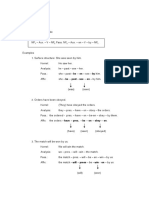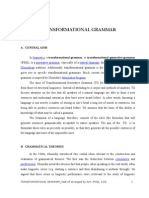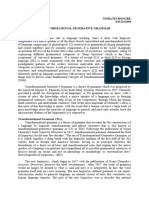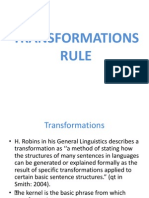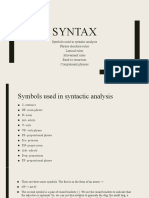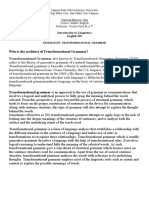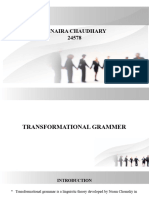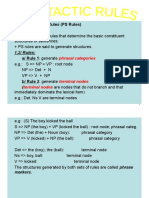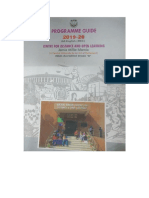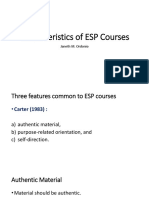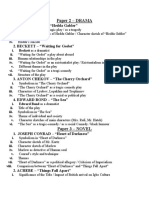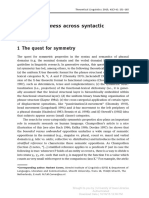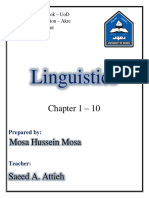Lecture Three
Revisions in the Generative Model
3.0. The Earliest Generative Models: A Recap
In the earliest models of generative grammar (Figure 2 on page 7), syntax comprises phrase
structure and transformational rules. With phrase structure rules, we were able to generate phrase
markers referred to as Deep Structure. Transformational rules relate this phrase marker to another
one referred to as Surface Structure. We looked at several kinds of transformations; all of them
perform one or more of four operations: insertion, deletion, substitution and movement.
Insertion: transformational rules can add new items to a sentence. For example Do-support
introduces the verb do when there is no overt morpheme under the tense node as in “she likes
flowers” → Does she like flowers? Your response to the question might yes or no. If the
answer is negative, there will be another new word to show negation She likes flowers → She
does not like flowers.
____________ language (write the name of an African language; then add examples)
Tip: make a statement and then negate or change it to a question in the language. Write down the
sentence that has words which are not in the declarative.
Statement:
Morpheme by morpheme:
Literal translation:
Deletion: to avoid repetition, transformations can delete words which re-occur in a sentence.
Usually, the words can be recovered from the context of the sentence. For example in English,
you can delete a verb from compound sentences like Peter plays the piano and Paul plays the
guitar. You can also delete complementizers like ‘that’ in sentences like “I hope that you read for
the test” The rule also derives imperative from declarative sentences as in you will do it yourself →
You will do it yourself! You should never tell a lie → Never tell a lie!
____________ language (write the name of an African language; then add examples)
Tip: make imperative sentences, or declarative sentences with verbs that take a CP as their
complement (examples on page 4). Then try complementizer deletion as in the example above.
Statement:
Morpheme by morpheme:
Literal translation:
Substitution: another way transformations handle repetition is substitution of re-occurring words.
For example, if two noun phrases in a sentence refer to the same entity you can either delete or
substitute with a pronoun.
Augusta speaks English and Augusta speaks French too.
Augusta speaks English and Augusta speaks French too (deletion)
Augusta speaks English and she speaks French too (substitution)
____________ language (write the name of an African language; then add examples)
Tip: Another example is on page 10; the last question in assessment test III.
Statement:
Morpheme by morpheme:
Literal translation:
Movement: transformational rules can rearrange the constituents in a sentence so that we can
establish the correct linear order (e.g. Affix Hopping). Movement also derives other kinds of
sentences like passives in English, WH-questions and focus constructions.
• WH-Questions
Ẹdo language
1. Osarrọ tie ebe → De ebe ne Osarrọ tie
Osaro read book QM book REL Osaro read
16
� Osaro is reading a book Which book is Osaro reading?
Yoruba language
2. Ámẹ̀bọ gbọ́ ìtàn kan → Ìtàn mélòó ni Ámẹ̀bọ gbọ́
Amẹbọ hear story one story QM be Amẹbọ hear
Amẹbọ heard a story How many stories did Amẹbọ hear?
• Focus constructions
Igbo language
3. Òbí hụ̀rụ̀ Àdá na áhíá → Àdá kà Òbí hụ̀rụ̀ na áhíá
Obi saw Ada at market Ada FOC Obi saw at market
Obi saw Ada at the market. It was Ada Obi saw at the market
Urhobo language
4. Ẹ́sè dẹ́ íkó vwẹ̀ èkì → Íkó ọ́yèn Ẹ́sè dẹ́rè vwẹ̀ èkì
Ese bought cup at market cup that Ese bought at market
Ese bought cups at the market It was cups that Ese bought at the market
Tips: You find movement whenever a noun phrase appears in a position different from the one
defined for its function. For example, in SVO languages, V and P precede direct object and
indirect object NP respectively. If you find an NP which functions as an object anywhere else in the
sentence, movement has occurred. The same applies to an NP which functions as subject; the
question in example 1 could be rephrased as De Osarrọ ne ọ tie ebe “which Osaro is reading a
book?” Often, movement transformation involves other kinds of transformational rules; in the
examples above there is insertion of question and focus markers.
3.1. The need for revisions
There have been five major revisions to the Chomsky’s model of generative syntax: Standard
Theory, Extended Standard Theory, Revised Extended Standard theory, Principles and
Parameters Theory and the Minimalist Program. Each revision was inspired by the need to provide
an adequate and universally applicable description of grammar. Adequacy refers to the evidence
which support one’s claims about language. There are three levels of adequacy: observational,
descriptive and explanatory. Observational adequacy accounts for existent data. At this level,
one can correctly generate sentences in the sample. Descriptive adequacy generates sentences,
accounts for native speakers’ judgment on acceptability and well-formedness. At this level, one
can make general statements about regularities in the language. Explanatory adequacy
observes the language, describes the native speakers’ intuitions about structures and explains
how language is acquired.
3.2. Standard Theory (ST)
Standard theory uses the same rules as previous models. The difference in the theory lies in the
sub-division of syntax into base and transformational components, as well as defining the mapping
from syntax to semantics and phonology.
3.2.1. Base Component
The base component generates the Deep Structure. It comprises the lexicon and rules for
generating phrase markers (PS rules), adding words to the trees (lexical insertion rules), choosing
complements (sub-categorization) and matching meaning (selectional restriction rules).
Lexicon: the lexicon is a list of all words in a given language. The list specifies features such as
the category of a word, the contexts it occurs, its meaning and pronunciation. The lexicon is similar
to the dictionary because of the information it contains; it differs from print and digital dictionaries
because it exists in the minds of language users.
17
�Phrase Structure Rules: phrase structure rules provide information about the categorial and
functional properties of constituents in a construction. Each rule is a formula which shows how the
constituent represented by a symbol on the left side (or flat end) of an arrow can be derived. For
example, the rule for sentences is S→NP INFL VP. Each symbol on the right side (pointed end) of
the arrow has its own formula. Using phrase structure rules, one can generate phrase markers
with the different types of nodes. To derive an actual utterance, one needs rules which apply to
lexical items.
Lexical Insertion Rules: these are rules which guide insertion of words into terminal nodes. Like
phrase structure rules, they consist of an arrow and categorial symbols. The difference lies on the
right side of the arrow. Every symbol in a lexical insertion rule is rewritten as a word; for example,
N and V will have rules such as N → table, N → chair, N → library, N → examinations, V → read,
V → sit, V → study etc. There are two formats for lexical insertion: matching and substitution.
Matching pairs the semantic and syntactic feature of a word to its position on the tree. Substitution
replaces one word with another from the same category. This is less accurate as it could yield
unacceptable sentences.
(Strict) Subcategorization Rules: these rules rely on categorial (parts of speech) and contextual
(the positions where a word can occur) features. Sub-categorization rules are restrictions on the
categories a given head can take as its complement. The rules are specified as frames; the blank
line represents the position of the word, while the symbols represent its contextual features (the
categories that it requires). We saw some examples while discussing verbal features in lecture
one (page 4). Apart from verbs, other categories also have sub-categorization rules.
Reliance [___ PP] She wrote the notes with reliance on the works of others.
During [ ___ NP] Some students traveled during the semester break.
Fond [ ___ PP] The baroness is fond of captain.
Sure [ ___ {PP / CP}] Captain is sure of himself.
Captain is sure that his children have been climbing trees.
When a word requires items from a particular word class, not all the expressions in that category
can function as complement of the word. So, it is possible for a structure to judged unacceptable,
even when you have closely followed the rules. The reason is that there are semantic restrictions
on the use of words. In the examples beside the subcategorial frames, there are three
prepositions: on, during and of. Although they are all heads of PP, we cannot use them
interchangeably. This means that the model needs to consider not only the categorial and
contextual features, but also the interpretational properties of a word.
Selectional Restriction Rules: these rules specify the possible combination of words. Selectional
restriction uses inherent semantic features of a word (+HUMAN, +ANIMATE, +CONCRETE etc) to
determine whether that word can occur with another. For example, words like breathe, pregnant,
hatch will select animate nouns as their subject. The subject for breathe needs to be a living thing
with the ability to respire; the nominal feature which captures this is [+ANIMATE]. So, we can
make a sentence like “the girl is still breathing”. The words pregnant and hatch also select animate
subjects, but those subjects have to be [+ FEMALE] and [+ HUMAN] or [+ AVIAN]. With these
features, we can have sentences like “the dog was pregnant” and “the chicken hatched an egg”.
These restrictions also apply to languages other than English.
Ẹdo language
1. Ọfọ fọ mwẹ 2. Egbe wọọ ẹre
sweat perspire 1SG body be_tired 3SG
I am sweating. He/She is feeling tired.
3. Ovbe hun iran
sleep be_sleepy 3PL
They are feeling sleepy.
18
�For those Ẹdo verbs to express their intended meanings, the choice of subject is restricted to the
lexical noun in each sentence. How do you communicate the same information in your language?
Are there any restrictions on the nouns? Another example is the pair of words “pluck” and
“harvest”; we use pluck for fruits, flowers and vegetables, and harvest for crops like cassava,
potatoes and yam. Find out the words for pluck and harvest in your language, and determine
whether there are restrictions on the nouns they occur with.
3.2.2. Transformational Component
The transformational component consists of rules which change a given phrase marker into
another. The role of this component is to convert the Deep (underlying) Structure into Surface
(derived) Structure. The Deep Structure serves as input to the semantic component which
provides the semantic interpretation. Surface Structure is the input to the Phonological component
which provides the phonetic interpretation of the sentence. In this theory, meaning was determined
before transformations applied to the Deep Structure.
3.2.3. Inadequacy of Standard Theory
The assumption in Standard Theory is that transformations are meaning preserving. If two Surface
Structures are derived from the same Deep Structure, and they differ because of an optional
transformation, both sentences must have the same meaning. This is not entirely correct;
sometimes optional transformations affect semantic interpretation.
1. (a) Delilah cut Samson’s hair
(b) Samson’s hair was cut by Delilah.
2. (a) Everyone in this class knows two languages
(b) Two languages are known by everyone in this class
In example 1(a) and (b), we have two sentences that differ only because of the passive
transformation. Their meanings are the same, so passivization does not have any effects on
interpretation. However, one cannot extend this analysis to the other pair of examples. Example
2(a) means everyone in this class is bilingual whereas 2(b) means that everyone in this class
know the exact same languages. Examples like 2(a) and (b) show that Surface Structure is also
relevant to semantic interpretation.
ASSESSMENT TEST V
A. Consider the following sentences answer the questions below.
1. (a)The protesters were arrested by the police. (b) The police arrested the protesters.
2. (a) I told him to turn down the volume. (b) I told him to turn the volume down.
3. (a) Yesterday, Hansel helped Gretel. (b) Hansel helped Gretel yesterday.
4. (a) My bicycle was stolen. (b) Someone stole my bicycle.
5. (a) The thief killed the thief. (b) The thief killed himself.
6. (a) Miley said she can buy herself flowers. (b) Miley said that Miley can buy Miley flowers.
i. Which one is the underlying form in those pairs of sentences?
ii. What transformations applied: Insertion, Deletion, Substitution, and / or Movement?
iii. Draw phrase markers for the derived form in each pair.
B. Discuss the ill-formedness of the following sentences.
1. John amazed the injustice of that decision. 3. I will put you the answer.
2. The book dispersed. 4. The garden weeded John.
i. State the rules which have been violated.
ii. How can one repair the violations? Provide examples to support your answer.
19
